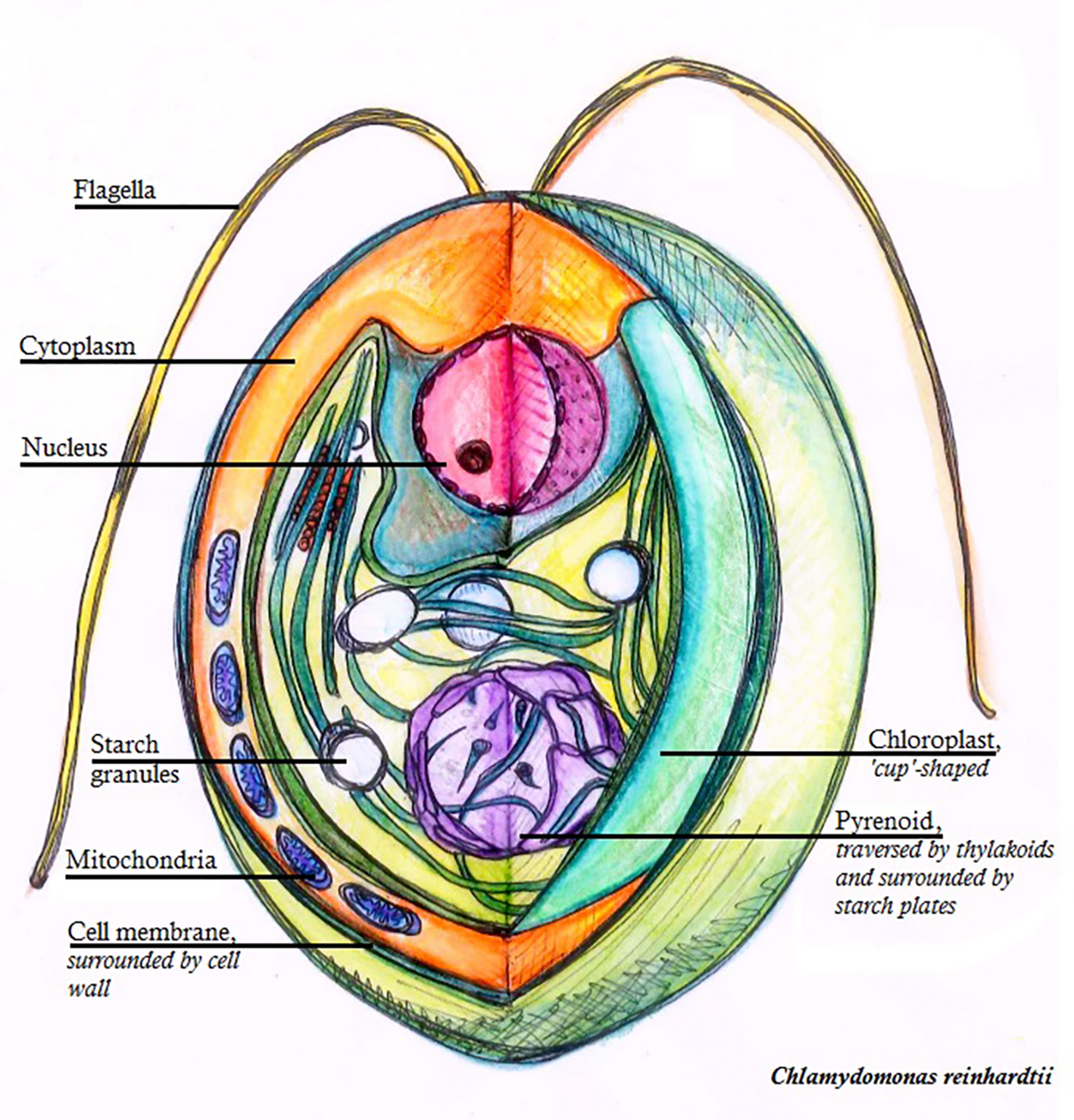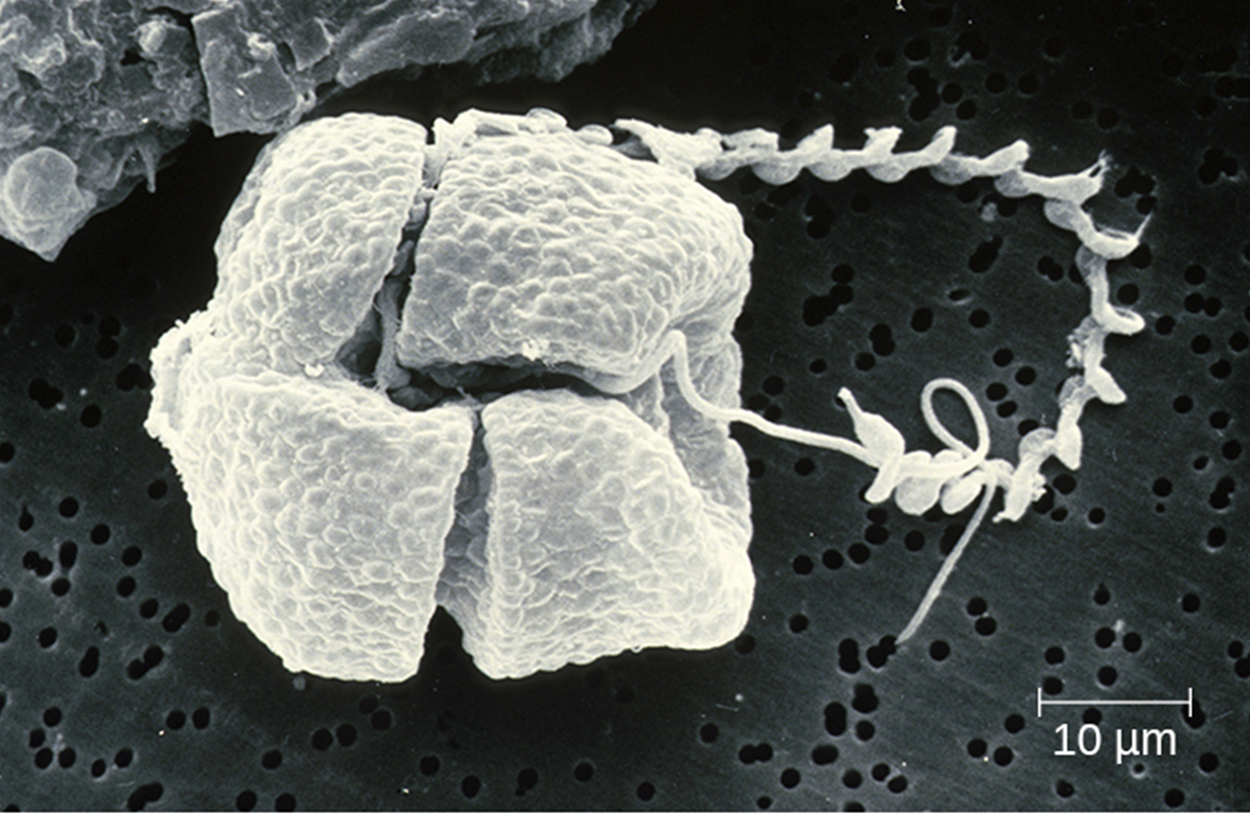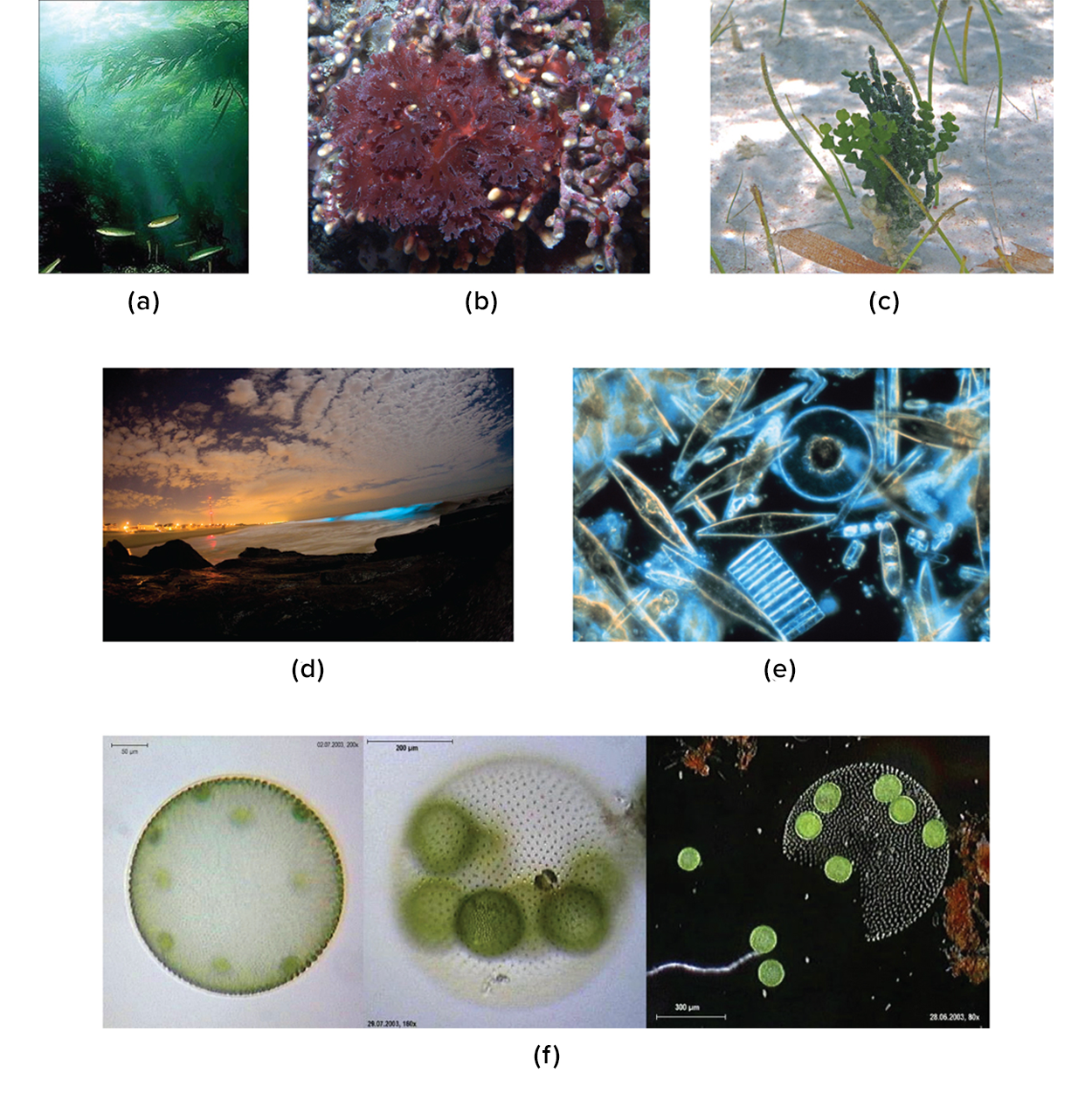Table of Contents |
The term “algae” is very broad. Although this word is now used to refer specifically to diverse protists, it was previously used to describe the cyanobacteria (Domain Bacteria) as “blue-green algae” and this term still appears sporadically. Because so many taxonomic groups of protists and sometimes even the cyanobacteria are called algae, it is important to be sure that you know how the term is being used in any specific context. In this lesson, we will use the term “algae” to refer only to eukaryotes.
Algae are autotrophic protists that can be unicellular or multicellular. The dinoflagellates, diatoms, golden algae, and brown algae are classified as TSAR (formerly within supergroup Chromalveolata). The red and green algae are classified under Archaeplastida.
Algae are important ecologically, environmentally, and economically because they are responsible for the production of approximately 70% of the oxygen and organic matter in aquatic environments. They are at the base of many food webs. Some types of algae, even those that are microscopic, are regularly eaten by humans and other animals. Algae are also the source of agar, agarose, and carrageenan that are used as solidifying agents in the laboratory and in food production.
Although algae are not pathogenic, some species produce toxins. Algal blooms occur when algae grow quickly and produce dense populations. This can result in the release of large quantities of toxins that harm aquatic animals and humans. Additionally, the decomposition of these algae uses up oxygen and produces “dead zones” as organisms die in these zones from lack of oxygen.
Like protozoans, algae often have complex cell structures. Algal cells can have one or more chloroplasts that contain structures called pyrenoids to synthesize and store starch. The chloroplasts themselves differ in their number of membranes, which is indicative of secondary or rare tertiary endosymbiotic events. Primary chloroplasts have two membranes, one from the original cyanobacterium that the ancestral eukaryotic cell engulfed and one from the plasma membrane of the engulfing cell. Chloroplasts in some lineages appear to have resulted from secondary endosymbiosis, in which another cell engulfed a green or red algal cell that already had a primary chloroplast within it. The engulfing cell destroyed everything except the chloroplast and possibly the cell membrane of its original cell, leaving three or four membranes around the chloroplast. Different algal groups have different pigments, which are reflected in common names such as red algae, brown algae, and green algae.

The image on the left shows an example of a pyrenoid within the chloroplast of a green algae, Chlamydomonas reinhardtii, as well as other basic algal structures. Note, however, that there is great diversity among the algae and that this is only one example.
Seaweed are macroscopic and may be confused with plants, but there are important distinctions. Seaweed do not have true tissues or organs like plants do. Additionally, seaweed do not have a waxy cuticle to prevent desiccation.
Algae have a variety of complex life cycles. Reproduction may be asexual by mitosis or sexual using gametes. Some green algae have life cycles with important similarities to the life cycles of green plants because these groups are relatively closely related.
In the previous section, we discussed the characteristics of various types of algae, including the fact that the term is very broad. Algae are highly diverse. They spread across many taxonomic groups, which explains why there is such high diversity. As with other microbes, it is important to be aware of changes in terminology. This lesson provides a brief introduction to the types of algae, highlighting examples with ecological, medical, or industrial relevance.
Dinoflagellates are mostly marine organisms and many species are planktonic. They have a variety of nutrition types and may be phototrophic, heterotrophic, or a combination (mixotrophic). They generally have two flagella. Some have cellulose plates that form a hard outer covering, or theca. Those that are photosynthetic use chlorophyll a, chlorophyll  , and other photosynthetic pigments. Additionally, some dinoflagellates produce neurotoxins that can cause paralysis in humans and other animals.
, and other photosynthetic pigments. Additionally, some dinoflagellates produce neurotoxins that can cause paralysis in humans and other animals.
When a population of dinoflagellates becomes particularly dense, a red tide (a type of harmful algal bloom) can occur. Red tides cause harm to marine life and to humans who consume contaminated marine life. The term “harmful algal bloom,” or HAB, is often used to distinguish between harmful red tides and other types of red tides (Anderson et al., 2021).
The micrograph below shows a dinoflagellate with a theca.

The stramenopiles include the golden algae (Chrysophyta), the brown algae (Phaeophyceae/formerly Phaeophyta), and the diatoms (Bacillariophyta). Stramenopiles have chlorophyll a, chlorophyll  /
/ , and fucoxanthin as photosynthetic pigments. Their general storage carbohydrate is chrysolaminarin. Some lack cell walls. Some have scales.
, and fucoxanthin as photosynthetic pigments. Their general storage carbohydrate is chrysolaminarin. Some lack cell walls. Some have scales.
Diatoms have frustules, which are outer cell walls of crystallized silica. The fossilized remains of diatoms are used to produce diatomaceous earth, which is used for filtration and insulation. Additionally, diatoms can reproduce sexually and asexually.
Brown algae are multicellular marine seaweed. Some can be extremely large, such as the giant kelp (Laminaria). They have leaf-like blades, stalks, and structures called holdfasts that are used to attach to a substrate. However, these are not true leaves, stems, or roots and do not contain vascular tissue. Their photosynthetic pigments are chlorophyll a, chlorophyll c, β-carotene, and fucoxanthin. They use laminarin as a storage carbohydrate.
The Archaeplastids include a group of green algae (Chlorophyta), the red algae (Rhodophyta), another group of green algae (Charophyta), and the land plants. The Charophyta are currently thought to be the most similar to land plants, with which they share a mechanism of cell division and an important biochemical pathway. Like land plants, the Charophyta and Chlorophyta have chlorophyll a and chlorophyll b as photosynthetic pigments, cellulose cell walls, and starch as a carbohydrate storage molecule.
Below are photos of algae. Photo (a) shows kelp, a type of brown algae. Photo (b) shows red algae. Photo (c) shows green algae. Photo (d) shows bioluminescence produced by dinoflagellates. Photo (e) shows diatoms. Photo (f) shows the colonial green alga Volvox.

Source: THIS TUTORIAL HAS BEEN ADAPTED FROM OPENSTAX “MICROBIOLOGY.” ACCESS FOR FREE AT openstax.org/details/books/microbiology. LICENSE: CC ATTRIBUTION 4.0 INTERNATIONAL.
REFERENCES
Anderson, D. M., Fensin, E., Gobler, C. J., Hoeglund, A. E., Hubbard, K. A., Kulis, D. M., Landsberg, J. H., Lefebvre, K. A., Provoost, P., Richlen, M. L., Smith, J. L., Solow, A. R., & Trainer, V. L. (2021). Marine harmful algal blooms (HABs) in the United States: History, current status and future trends. Harmful algae, 102, 101975. doi.org/10.1016/j.hal.2021.101975
Diaz, R. J., & Rosenberg, R. (2008). Spreading dead zones and consequences for marine ecosystems. Science (New York, N.Y.), 321(5891), 926–929. doi.org/10.1126/science.1156401
Froehlich, H. E., Afflerbach, J. C., Frazier, M., & Halpern, B. S. (2019). Blue Growth Potential to Mitigate Climate Change through Seaweed Offsetting. Current biology : CB, 29(18), 3087–3093.e3. doi.org/10.1016/j.cub.2019.07.041
Joyce S. (2000). The dead zones: oxygen-starved coastal waters. Environmental health perspectives, 108(3), A120–A125. doi.org/10.1289/ehp.108-a120
Lavery, A. M., Backer, L. C., Roberts, V. A., DeVies, J., Daniel, J., & DHSc1 (2021). Evaluation of Syndromic Surveillance Data for Studying Harmful Algal Bloom-Associated Illnesses - United States, 2017-2019. MMWR. Morbidity and mortality weekly report, 70(35), 1191–1194. doi.org/10.15585/mmwr.mm7035a2
Lean, I. J., Golder, H. M., Grant, T., & Moate, P. J. (2021). A meta-analysis of effects of dietary seaweed on beef and dairy cattle performance and methane yield. PloS one, 16(7), e0249053. doi.org/10.1371/journal.pone.0249053
Laurens, L., Lane, M., & Nelson, R. S. (2020). Sustainable Seaweed Biotechnology Solutions for Carbon Capture, Composition, and Deconstruction. Trends in biotechnology, 38(11), 1232–1244. doi.org/10.1016/j.tibtech.2020.03.015
Li, Y., Zheng, Y., Zhang, Y., Yang, Y., Wang, P., Imre, B., Wong, A., Hsieh, Y., & Wang, D. (2021). Brown Algae Carbohydrates: Structures, Pharmaceutical Properties, and Research Challenges. Marine drugs, 19(11), 620. doi.org/10.3390/md19110620
Parker, N., Schneegurt, M., Thi Tu, A.-H., Lister, P., & Forster, B. (2016). Microbiology. OpenStax. Access for free at openstax.org/books/microbiology/pages/1-introduction
Pyrenoid. (2021, November 29). In Wikipedia. en.wikipedia.org/wiki/Pyrenoid
Roque, B. M., Venegas, M., Kinley, R. D., de Nys, R., Duarte, T. L., Yang, X., & Kebreab, E. (2021). Red seaweed (Asparagopsis taxiformis) supplementation reduces enteric methane by over 80 percent in beef steers. PloS one, 16(3), e0247820. doi.org/10.1371/journal.pone.0247820
Soo, R. M., Hemp, J., & Hugenholtz, P. (2019). Evolution of photosynthesis and aerobic respiration in the cyanobacteria. Free radical biology & medicine, 140, 200–205. doi.org/10.1016/j.freeradbiomed.2019.03.029
Vijn, S., Compart, D. P., Dutta, N., Foukis, A., Hess, M., Hristov, A. N., Kalscheur, K. F., Kebreab, E., Nuzhdin, S. V., Price, N. N., Sun, Y., Tricarico, J. M., Turzillo, A., Weisbjerg, M. R., Yarish, C., & Kurt, T. D. (2020). Key Considerations for the Use of Seaweed to Reduce Enteric Methane Emissions From Cattle. Frontiers in veterinary science, 7, 597430. doi.org/10.3389/fvets.2020.597430